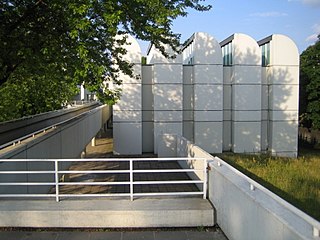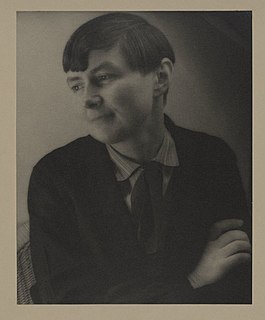Catharine Louise "Kitty" van der Mijll Dekker (1908-2004) was a Dutch textile artist. [1] She studied at the Bauhaus and her designs are still being produced.
Catharine Louise "Kitty" van der Mijll Dekker (1908-2004) was a Dutch textile artist. [1] She studied at the Bauhaus and her designs are still being produced.
Mijll Dekker was born on 22 February 1908 in Yogyakarta Dutch East Indies. [2] In 1916 the family returned to the Netherlands. [3] Around 1922 Mijll Dekker studied drawing at the Royal Academy of Art, The Hague and from 1926 through 1927 she studied at Hornsey College of Art in London. [4] From 1927 through 1929 she studied interior design with Cor Alons . [5] From 1929-1932 she studied at Walter Gropius' Bauhaus in Dessau, Germany. [4] Gropius allowed both men and women into his art school, but relegated women to a workshop where they studied crafts, mainly weaving. [6] Her teachers at the Bauhaus included Anni Albers, Otti Berger, Wassily Kandinsky, Paul Klee, Lilly Reich, Oskar Schlemmer, and Gunta Stölzl. [4]
From 1932 through 1966 Mijll Dekker owned a commercial hand weaving mill Handweverij en Ontwerpatelier K.v.d. Mijll Dekker. During the same time frame she worked for the linen weaving mill E.J.F. van Dissel & Zn. From 1934 through 1970 she taught at the Kunstnijverheidsschool Quellinus in Amsterdam. Her students included Marjanne Doeksen, Dook van der Heijden, Willy Pennings, Margot Rolf, Désirée Scholten, and Herman Scholten. Mijll Dekker was a member of the artists society, Arti et Amicitiae. [4]
In 1933 Mijll Dekker won a Silver medal at the Milan Triennial. [5] In 1935 she won a Gold medal at the Brussels International Exposition as well as the Prix d'honneur (Paris). In 1936 she exhibited at the 1936 World's Fair winning a Gold medal. The same year she received a Quellinus Prize. [4]
Mijll Dekker married Hermann Fischer in 1950. [4] Mijll Dekker died on 6 December 2004 in Nijkerk. [2] Her work is in the Stedelijk Museum Amsterdam. [7] Her 1935 design for a dish cloth is still being produced for the TextielMuseum in Tilburg. [8] [9]

Johannes Itten was a Swiss expressionist painter, designer, teacher, writer and theorist associated with the Bauhaus school. Together with German-American painter Lyonel Feininger and German sculptor Gerhard Marcks, under the direction of German architect Walter Gropius, Itten was part of the core of the Weimar Bauhaus.

Anni Albers was a German-born American textile artist and printmaker credited with blurring the lines between traditional craft and art.
Besides surface qualities, such as rough and smooth, dull and shiny, hard and soft, textiles also includes colour, and, as the dominating element, texture, which is the result of the construction of weaves. Like any craft it may end in producing useful objects, or it may rise to the level of art.

The Bauhaus Archive is a state archive and Museum of Design located in Berlin. It collects art pieces, items, documents and literature which relate to the Bauhaus School (1919–1933), and puts them on public display. Currently, the museum is closed due to construction works and will reopen in 2022. It has a temporary space at Knesbeckstr. 1-2 in Berlin-Charlottenburg.

Artus Quellinus also known as Artus (Arnoldus) Quellijn, Artus Quellinus I or Artus Quellinus the Elder was a Flemish sculptor. He is regarded as the most important representative of the Baroque in sculpture in the Southern Netherlands. His work had a major influence on the development of sculpture in Northern Europe.

Gunta Stölzl was a German textile artist who played a fundamental role in the development of the Bauhaus school's weaving workshop. As the Bauhaus' only female master she created enormous change within the weaving department as it transitioned from individual pictorial works to modern industrial designs. Her textile work is thought to typify the distinctive style of Bauhaus textiles. She joined the Bauhaus as a student in 1920, became a junior master in 1927 and a full master the next year. She was dismissed for political reasons in 1931, two years before the Bauhaus closed under pressure from the Nazis.

Rombout Verhulst was a Flemish sculptor and draughtsman who spent most of his career in the Dutch Republic. There he helped introduce the Baroque style in sculpture while becoming the leading sculptor of marble monuments, including funerary monuments, garden figures and portraits.

Jonkheer Willem Jacob Henri Berend Sandberg known as Willem Sandberg was a Dutch typographer, museum curator, and member of the Dutch resistance during World War II.

Roelof Paul Citroen was a German-born Dutch artist, art educator and co-founder of the New Art Academy in Amsterdam. Among his best-known works are the photo-montage Metropolis and the 1949 Dutch postage stamps.

Arieh Sharon was an Israeli architect and winner of the Israel Prize for Architecture in 1962. Sharon was a critical contributor to the early architecture in Israel and the leader of the first master plan of the young state, reporting to then Prime Minister, David Ben-Gurion. Sharon studied at the Bauhaus in Dessau under Walter Gropius and Hannes Meyer and on his return to Israel in 1931, started building in the International Style, better known locally as the Bauhaus style of Tel Aviv. Sharon built private houses, cinemas and in 1937 his first hospital, a field in which he specialized in his later career, planning and constructing many of the country's largest medical centers.

Gertrud Arndt was a German photographer associated with the Bauhaus movement. She is remembered for her pioneering series of self-portraits from around 1930.

Charlotte Ida Anna "Lotte" Stam-Beese was a German-Dutch architect and urban planner who helped with the reconstruction of Rotterdam after World War II.

Otti Berger was a textile artist and weaver. She was a student and later teacher at the Bauhaus.

Martine Theodora Bax is a Dutch-Canadian art historian and art critic in modern art. Her specializations are the work of Piet Mondrian and the relationship between art and Western Esotericism, especially Modern Theosophy and Anthroposophy.
Margaretha Reichardt, also known as Grete Reichardt, was a textile artist, weaver, and graphic designer from Erfurt, Germany. She was one of the most important designers to emerge from the Bauhaus design school's weaving workshop in Dessau, Germany. She spent most of her adult life running her own independent weaving workshop in Erfurt, which was under Nazi rule and then later part of communist East Germany.
Wall Hangings was an exhibition of textile fiber art at Museum of Modern Art from 25 February to 4 May 1969. It was planned in 1966 and toured 11 cities in 1968–1969.

The Bauhaus was seen as a progressive academic institution, as it declared equality between the sexes and accepted both male and female students into its programs. During a time when women were denied admittance to formal art academies, the Bauhaus provided them with an unprecedented level of opportunity for both education and artistic development, though generally only in weaving and other fields considered at the time to be appropriate for women.

Benita Koch-Otte, born Benita Otte, was a German weaver and textile designer who trained at the Bauhaus.

Marie van Regteren Altena (1868-1958) was a Dutch painter known for her still lifes.

Marie Heijermans or Marie de Roode-Heijermans (1859-1937) was a Dutch painter.

Sophie Verrijn Stuart (1890–1946) was a Dutch ceramicist.